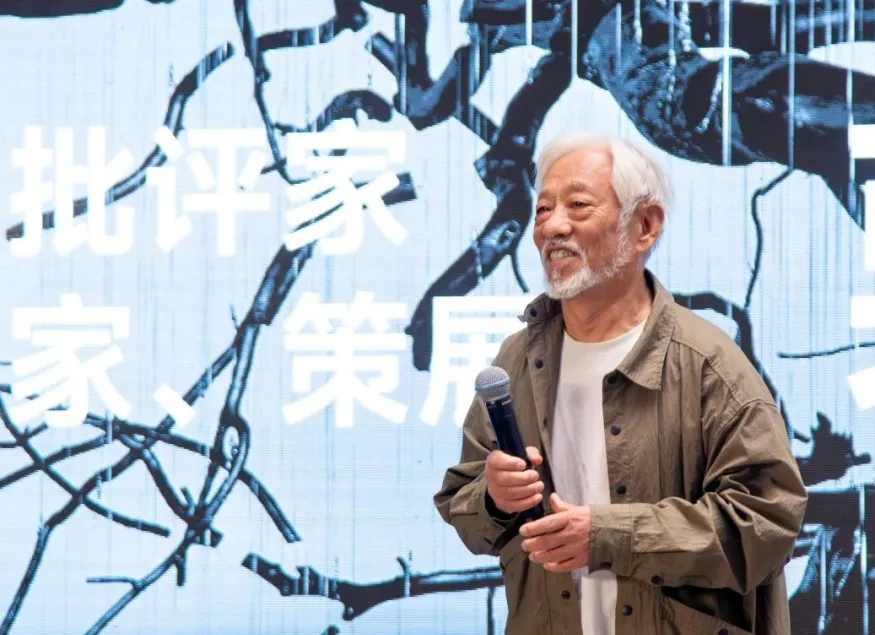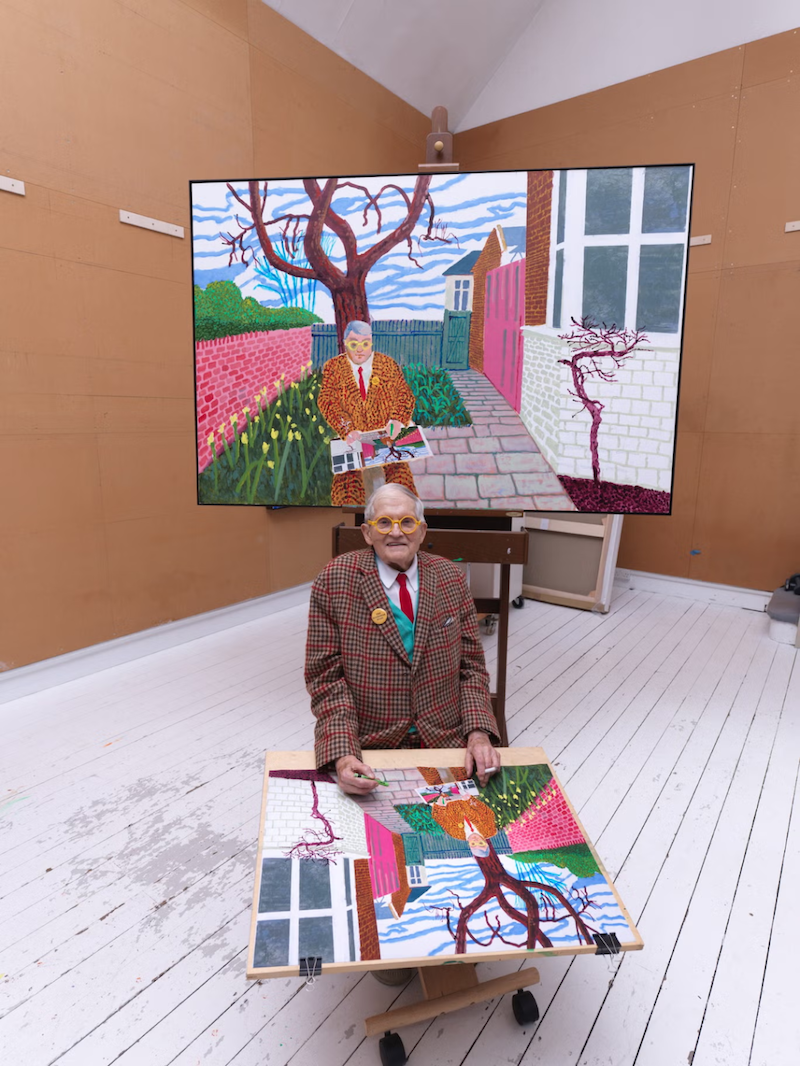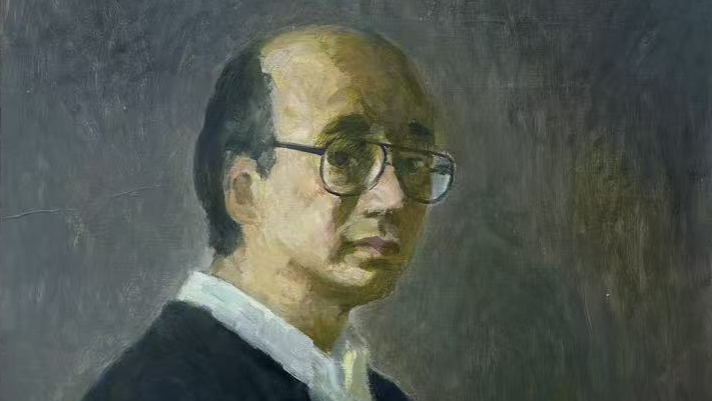
In China's contemporary art world, Li Xianting, known as Lao Li, was once regarded as a "godfather-like figure.
This 76-year-old man, with white hair and beard, has been away from the contemporary art world for a long time. Recently, Li Xianting participated in the planning of the first exhibition of Xibei Contemporary Art Museum in Hohhot, Inner Mongolia, and was interviewed by The Paper. He said: " The essence of contemporary art is to 'truly face the living experience' rather than chasing style or market. Art should be stimulating and numb! Contemporary art is the artist's true expression of the real living environment and his thinking about society. The value of art does not lie in directly solving social problems, but in providing a perspective for reflection."

Li Xianting
Born in 1949, Li Xianting is a legendary figure in the field of Chinese art curation. In the 1980s and 1990s, he had a profound impact on the development of contemporary Chinese art. From an editor of fine arts within the system to an independent curator, from promoting trendy contemporary art to criticizing the market, in recent years he has called for a distinction between "art" and "works" - the former is the sincere feelings in creation, while the latter is a commodity priced by the market. When talking about artistic creation, he emphasized that artists should capture real ideas in life and express them, "Contemporary art is the artist's true expression of the real living environment, which inevitably includes thinking about social issues."
The Paper: You have proposed important artistic concepts such as "cynical realism" and "political pop", which have influenced the development of Chinese contemporary art. You are relatively low-key now. Do you think there are still some artistic concepts that can be refined for current art? What do you think of current Chinese contemporary art?
Li Xianting: The concept of art is timely. The development of Western modern art is also phased. For example, minimalist art is a rebellion against the over-idealization of pop art. In the 1980s, Chinese art was closely linked to social culture. The art trend from the late 1970s to the early 1990s was both a cultural phenomenon and a social trend. However, after the mid-1990s, with the intervention of international capital and the rise of consumer culture, art gradually became diversified and personalized, and group phenomena decreased.
The current art environment is different. Artists born in the 1970s once proposed the concept of "cruel youth", but artists born in the 1990s and 2000s lack common social experiences and find it difficult to form a unified art trend. This is not a bad thing, but a reflection of the diversity of the art ecology.

Li Xianting at the exhibition
The Paper: As an important promoter and curator of Chinese contemporary art, you have led and curated many landmark exhibitions, such as the "China Contemporary Art Exhibition". In the planning process of these exhibitions, how do you balance the purity of artistic expression and the social influence of the exhibition?
Li Xianting: This question is actually quite complicated. The relationship between the purity of art and its social influence has been a focus of debate in the Chinese art world since the May Fourth Movement. What is true "pure art"? I was thinking about this question when I was writing "Art Is Not Important". During the "85 New Wave" period, the art world began to reflect on "purity" - there was a trend at the time that opposed the social function of art, believing that paying attention to social issues would destroy the purity of art. Later, I gradually realized that the purity of art is not separated from society, but contains the social attributes themselves.
In 1999, I received a research grant from the Rockefeller Foundation and went to the United States for half a year. During that time, I visited Hans Haacke, a professor at the Cooper Union in New York. His works are very political. I asked him how he viewed the purity of art, and he asked back: "Are there pure people?" This gave me an epiphany.
The Paper : You have always emphasized the criticality and independence of art. In the current context where commercial capital is deeply involved in the art field and some curatorial projects tend to cater to market demand, how can curators uphold the purity and criticality of art and guide the audience to establish a deeper understanding of art?
Li Xianting: It depends on the curator's personal choice. I quit the art world because it was difficult to balance the relationship between business and art - the profit-seeking nature of capital often suppresses the critical nature of art. Curators need to clarify their own positions and insist on independent judgment. For example, Hans Haacke's work was cancelled by the Guggenheim Museum for exposing social problems. This persistence itself is a defense of the purity of art.
The Paper: Looking back at the development of contemporary art curatorship in China, there are certainly some things worth reflecting on. "Art, perhaps in the strictest sense, is the useless use of society," you said before. In the current era of traffic and the cacophony of voices, how do you think we should understand true contemporary art?
Li Xianting: In the past, curatorial practices have been overly formalistic, such as simplifying exhibitions into a combination of artworks and ignoring the intrinsic value of the works. In addition, some curators focus on the identity of the guests rather than the art itself, causing the exhibition to become a social tool.
As for the "useless use", the value of art is not to directly solve social problems, but to provide a perspective for reflection. For example, some works of art use symbolic expressions to trigger thinking about the state of existence. Contemporary art should maintain this independence and avoid being assimilated by consumerism in the era of traffic.
There is no need to set a "healthy" standard for the development of art. Just like competition in a free market, the collision of different styles and concepts is itself a manifestation of health. History will select truly valuable works, and contemporary people should allow art to grow naturally in diverse explorations.
The Paper: You are the curator of the first exhibition of Xibei Contemporary Art Museum. The artist in the exhibition, Meng Boshen, has been focusing on pencil creation for more than ten years, from smearing music scores, Braille versions of classic texts to ready-made products. You once commented that "the pencil itself has become his object of observation." His creative process is almost ascetic. Is this repetitive manual labor a resistance to the "speed worship" in the digital age? Does his behavior itself have more conceptual value than the result?
Li Xianting: I used the well-known word that Plato used when talking about aesthetics - "contemplation", which includes feelings such as observation, experience, judgment, and scrutiny. In fact, aesthetics or aesthetics, the original meaning of Latin does not have the meaning of "beauty", but is just a non-utilitarian and distant feeling of human beings.
Meng Baishen has been creating works with pencils since 2007. He has turned the "smearing" of childhood games into his creative language. At the same time, "smearing" also "observes" the "reality" of the changing times. The reality in reality may often be "smeared". The new works exhibited this time, such as "Scale", use the language of pencil smearing to include behavioral time. This is different from observing pebbles or trees. He will have some different feelings in his heart and will also produce different effects. For example, the focus on this ruler carries a rebellion or resistance to the rules, or questions: What is the relationship between human freedom and rules?

Exhibition view of "Suspension"

Exhibition view of "Suspension"
The Paper: In the works exhibited this time, you interpreted "Suspension" as "a symbol of the suffering of urbanization", and "River" proposed "equality of all stones" by covering the luster of stones. From textual criticism to attention to natural objects, what do you think? Do you still insist that "art should be tingling and numb"?

Exhibition site of River
Li Xianting : Pebbles are also natural "creations" of the impact of river water. What did Meng Boshen "reflect" by painting? Respect for nature! After the artist painted the pebbles, there is only a difference in size, and there is no difference between gemstones and ordinary pebbles. All stones are equal! For art, its symbolism is enough. I still insist that art is an attitude towards this society and the environment in which you live. I think the most important points of art are morality. This morality is not the ethics we talk about, but the most important one in morality. It is whether you can be sincere and true, that is, you are true to your feelings and have something to say. This is one of the most important points of art. When you have this kind of true attribute, including conscience and position, which are all moral factors in art, then you can say that I want to express it and find a suitable language. Therefore, contemporary art is actually an expression of people's feelings of survival in the real living environment. At the same time, this feeling also includes some different reactions that he has made to this society. With these different reactions, he has his attitude and position on some problems in this society.

Exhibition site of River
The Paper: Today, as Chinese contemporary art is deeply integrated into the global system, how do you view simple media such as “pencil smearing”?
Li Xianting: After 2000, capital has had the greatest impact on art. For example, in the Kassel Documenta and the Venice Biennale, many of the participating artists have agents behind them, promoted by galleries, and art fairs are everywhere. In this process, critics are not as important as before. Liu Yiqian once said, "Collectors have the final say on whether art is good or bad." In the past, it was the art academic community and the critics who had the final say. I used to be a consultant at Guardian Auctions and wrote an article for their internal publication, saying that academic value determines your price. But now it is not the case that your work will be sold at a high price if it is good. The art market has its own business logic. Value is suspended in a sense. Value is sometimes ignored in the process of commercial manipulation, especially now that it is becoming more and more obvious that this value system is becoming less and less effective.
The Paper: When you founded Songzhuang Art Museum, you advocated "non-profit". What suggestions do you have for emerging private art institutions? How do you think we can balance academic perseverance with the commercial pressure of private institutions?

Songzhuang Art Museum
Li Xianting: When I built Songzhuang Art Museum, I was faced with the formation of an entire artist community. Moreover, it was an art museum invested by a village committee, which determined that my operation was non-profit, and it mainly relied on sponsorship to hold each exhibition. In fact, I am not very clear about the operation of private enterprises and art museums. In the European and American systems, there are two models: one is a profit model, which relies on funds, galleries and auctions; the other is a non-profit direction, which is backed by a foundation, but the foundation establishes a relationship between the consortium and this non-profit space. For example, MOMA is a large modern art museum, but it is actually a private institution. The Rockefeller family is the main shareholder, and it is handed over to an academic team to operate, and it cannot make a profit.
The Paper: The rise of social media and digital technology has brought new opportunities and challenges to contemporary art curation. For example, online exhibitions and virtual curation continue to emerge. How do you view the impact of these emerging curatorial methods on traditional curatorial models, and their impact on the dissemination and value of Chinese contemporary art?
Li Xianting: Online exhibitions should coexist with traditional exhibitions. In the 1960s and 1970s, some people claimed that "painting is dead", but painting is still developing today. Although digital technology is convenient, it will cause the information of the original work to decay. For example, the on-site impact of installation art cannot be fully conveyed through photos. However, digital art itself is also creating new possibilities, such as AI-assisted creation and virtual curation, which should be seen as supplements rather than substitutes. AI can imitate but cannot surpass human improvisation, so the core of art will always belong to humans.


